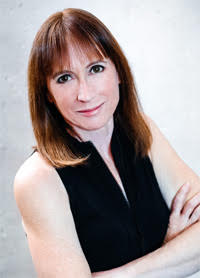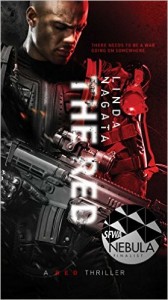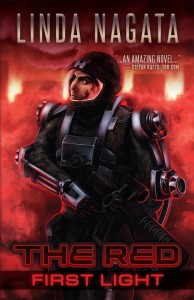 SFRevu: The Red: First Light was your first sf novel after a considerable hiatus, but you came out swinging, and it grabbed a Nebula nomination right off the bat. Then of course it caught the attention of Simon and Schuster. So, a couple of questions come to mind. First, what took you so long to get back to sf? And how do you think the time spent away affected you as a writer?
SFRevu: The Red: First Light was your first sf novel after a considerable hiatus, but you came out swinging, and it grabbed a Nebula nomination right off the bat. Then of course it caught the attention of Simon and Schuster. So, a couple of questions come to mind. First, what took you so long to get back to sf? And how do you think the time spent away affected you as a writer?
Linda Nagata: I stopped writing science fiction in large part because there seemed no point to it. Though my work had done well critically, I’d failed to connect with enough readers to sustain a career. At the same time, a lot of popular SF failed to connect with me. So I moved on to other things. I didn’t entirely quit writing, though it was close. But once a writer, always a writer. After I self-published my backlist, I started writing original fiction again, starting in fantasy because that made it a fresh start for me, completely different from anything I’d done before. I wrote a short secondary world fantasy novel called The Dread Hammer—a dark and darkly humorous look at love, war, murder, and marriage. I had a lot of fun with it, and proved to myself that I could still write. At that point, one of my long-time readers urged me to take up short fiction again—science fiction—and that went well. In fact, The Red arose directly from two of the short stories I wrote during this period.
The way I write has changed since my early books. I’m more willing to write fast, leaving holes in the first draft to be filled in later. Though I don’t think I was ever a wordy writer, my style is more spare now than before. Just enough and not a word more. That’s the goal, anyway.
SFRevu: What drew you into the genre? Who were your favorite authors as a young reader? Do you still have time for reading, and if so, who do you like?
Linda: From as far back as I can remember, I loved adventure stories, and I still do. Tales of exploration, new lands, seafaring, mountain climbing, harrowing escapes, quests—science fiction was a natural extension of that. Space faring. Exploring new worlds. I can remember reading a lot of Andre Norton as a kid. I remember trying Dune and bouncing off it, but when I picked it up a few years later, I loved it. A lot of what I read as a teen is lost to the mists of time, but my dad was a science fiction fan, so much of what he read, I read too.
I make time to read. I see it as part of the job description. I try to read widely, sampling a book or two from different authors, and in different genres. Some SF favorites from this year are Claire North’s The First Fifteen Lives of Harry August. This is an amazing, entrancing novel. I’ve also enjoyed Greg Bear’s War Dogs, and Nexus, by Ramez Naam. All highly recommended.
 SFRevu: Were you tempted to stay with self publishing for the Red trilogy? I know that you wanted to avoid the costs involved in shopping around the book, but putting it out yourself probably had other costs. What were they, and how does that experience compare to the traditional route?
SFRevu: Were you tempted to stay with self publishing for the Red trilogy? I know that you wanted to avoid the costs involved in shopping around the book, but putting it out yourself probably had other costs. What were they, and how does that experience compare to the traditional route?
Linda: I had fully intended to self-publish the Red Trilogy. I enjoyed the process, as well as the sense of control it gave me. I liked being able to make all the critical decisions, and I wasn’t looking for a publisher. But then, almost by chance I started talking to my agent again. He loved The Red and thought we could take the trilogy to a new level. I was skeptical. I still had my battle scars from my first foray into traditional publishing, and so it took some serious thinking and discussion with my husband before I was convinced to try traditional publishing again.
 The literal dollar cost of self-publishing didn’t add up to a lot for me. I code my own ebooks, and lay out my own pages for the print-on-demand editions. By the time The Red came out, I’d already created my own imprint (Mythic Island Press LLC) and bought my own ISBNs. My daughter, Dallas Nagata White, painted the cover illustration. But the abstract cost of self-publishing became more apparent later. It’s hard to get respect! I was an award-winning, hard science fiction writer with growing short fiction credits, but I could not convince most review sites to even consider my work. Fortunately for me, I did get reviews at a couple of major sites—Locus and Tor.com—and eventually at SF Signal.
The literal dollar cost of self-publishing didn’t add up to a lot for me. I code my own ebooks, and lay out my own pages for the print-on-demand editions. By the time The Red came out, I’d already created my own imprint (Mythic Island Press LLC) and bought my own ISBNs. My daughter, Dallas Nagata White, painted the cover illustration. But the abstract cost of self-publishing became more apparent later. It’s hard to get respect! I was an award-winning, hard science fiction writer with growing short fiction credits, but I could not convince most review sites to even consider my work. Fortunately for me, I did get reviews at a couple of major sites—Locus and Tor.com—and eventually at SF Signal.
With traditional publishing, The Red has gone out to many more review sites, and it’s available in many more locations than in its self-published edition. Saga Press has done a beautiful job with the books. The cover is fantastic, and they’ve released it in simultaneous hardcover, mass-market paperback, and ebook editions. And Audible has released an audiobook.
SFRevu: Did the book change at all between your edition and the new one? Where were you with the sequels when Simon and Schuster approached you?
Linda: When The Red was sold I knew there would be revisions, but it was important to me that it remain largely the same book that I’d published on my own, and Joe Monti, my editor at Saga Press, agreed. We went through a multi-step editorial process with the goal of enhancing the existing story, not rewriting it. Also, by this point I was working simultaneously on all three books of the trilogy, which led me to make a few more changes, mostly in terminology, to better integrate the three books. But the new edition of The Red has the same structure as the original, the plot remains the same, and no new characters have been added.
At the time the books sold, the second volume, The Trials was done. In fact, I was about to publish it under my own imprint, but withheld it pending the outcome of the auction. There were revisions to do on The Trials, but nothing too extensive.
The last volume, Going Dark, was barely begun at that point, and I spent last summer and fall working frantically on a draft.
SFRevu: One of the things I enjoy most about your writing is that while you put the action first, you don’t let it drive the science into absurd corners. I sometimes find myself rolling my eyes at the technology that some authors employ, but with you, I find myself wondering what journals you’ve been reading. So, how do you feel about hard versus soft science fiction, and what kind of research do you do?
Linda: I tend not to use the term “soft science fiction” because the meaning seems to change depending on circumstance. In my own mind, I see science fiction as a continuum between hard science fiction and space fantasy. At the harder end of the spectrum, technology in a story is more or less plausible and attempts are made not to violate basic laws of nature. Some say hard SF is focused on the technology, but for me, that’s not the defining characteristic. My stories aren’t about the technology. They’re about the characters and how their lives are affected by that technology. More and more, I’m fascinated by the possibilities in near-future, day-after-tomorrow fiction. We live in such an amazing world, and hard science fiction, or “high-tech” science fiction, gives us a way of exploring the possibilities of our world. That’s what really interests me.
As for research, I follow accounts on Twitter and Facebook that are good at highlighting interesting articles. And once I find something relevant to a story I’m telling, I track down as many references as I can or find a recent book written to cover the topic. The Internet has developed into an extraordinary resource in the years since I first started writing science fiction. Not just in the form of articles, but also readily available experts willing to answer questions. I’ve posed questions on Twitter and had two or three engineers provide answers in short order. Given that I live in a relatively remote location, this is an amazing advantage.
SFRevu: Bonus question: Are there any science fiction tropes that make you roll your eye? FTL? Consciousness uploads or downloads?
Linda: I can’t complain about consciousness up or downloads, since I employ those myself in the nanotech books and stories!
FTL, of course, is a literary device for linking diverse worlds in a story structure, and the concept has been handled in many, many clever ways. Still, FTL is something I personally avoid. My novel, Vast, was in part a reaction against stories in which getting to the next star system is about as challenging as driving to the next town along the Interstate.
One trope that does bug me—and this is more in film than in written fiction—is overpowered aliens. Specifically, alien life forms endowed with phenomenal strength and endurance, far beyond anything of comparable body mass on Earth. Biological life forms on Earth get tired when sprinting or fighting, and they get tired pretty quickly, for good, physiological reasons. But for the most part, aliens in film seem to have developed much more efficient musculature and metabolism! The aliens in the movie Cowboys and Aliens are a good example of this. They just never slow down.
SFRevu: “Juiced up” soldiers dosed to ramp up aggression or tamp down fear have occasionally shown up in sf. With your linked soldiers, on the other hand, the objective seems largely to keep them rational and to protect them from the psychological damage from combat. There’s research about using antidepressants to prevent formation of traumatic memories, but your soldiers never come off their protective highs, so did you really do them any favors? To what extent does this dovetail with your LOV ideas?
Linda: In The Red the soldiers have become addicted to the neuromodulation that was meant to protect them. It’s an example of a beneficial technology not working out quite as planned. The technology’s original purpose was to allay damage from stress, to maintain a peak state of alertness at need, to allow sleep at need, to dampen destructive moods. But the soldiers become dependent on this “emo drip” and crash hard if it’s taken away. On the other hand, they are more efficient at their jobs, so the overall goal of the mission is advanced.
I hadn’t really thought about how this parallels some ideas in Limit of Vision, but you’re right. I’m interested in brain state, in emotions. For example, it’s fascinating to me (and depressing and frustrating) how dependent my own creativity is on my emotional state. I would love to be able to adjust my brain state to obtain, on-demand, the confidence and enthusiasm that goes along with my best work!
SFRevu: In The Red: First Light, you came up with the idea that the breeding ground for AI would be marketing software. Personally, I put my money on spam and viruses, but your idea of the “Red” as a force to create happy consumers was much more fun. Where did the idea come from, and how does it look from where you stand now?
Linda: I think it was initially inspired by the creepy way that ads follow us around the Internet after we’ve viewed a particular product, and by the way that Google can record our browsing histories, and Amazon is in a position to map our lives from what we buy. And of course there is Facebook and Twitter in which we volunteer vast amounts of information about ourselves. I’ll still stand behind the marketing software as my AI source material—a highly competitive environment based on big data.
SFRevu: You’ve written quite a bit of fantasy, for which you’ve gotten pretty good recognition, but now you’ve come back to SF, and Mil-SF at that, which you do very, very well. We note that in addition to the First Light trilogy, you also take point with your short story “Codename: Delphi” in The Year’s Best Military SF & Space Opera, out last month. What was your literary call to arms?
Linda: Logically, I should not have written these books. I knew when I started that I was taking a huge chance. I didn’t have a military background, or a good marketing angle, but I really wanted to write the story. Military fiction brings together so many of the themes that have always drawn me to fiction: honor, duty, action, physical challenges, moral questions, technology, and a means to examine real-world policies and politics—although this only became clear to me much later.
The Red really got its start with a near-future story I wrote called “Through Your Eyes” which featured a character named James Shelley. The story went off to market, but Shelley was still in my head, insisting he wasn’t done yet. I considered different paths for his continuing story, and eventually recalled that in the story, military service is mentioned as something that neither Shelley nor his friends would ever willingly consider. With that in mind, it was suddenly obvious to me that military service was exactly the direction that Shelley’s story needed to go.
Beyond that, the prominence of the military in the American mind after 9/11, our prolonged conflicts, and on a more personal level, having two of the young men in our family in-service, surely influenced the direction of my work.
SFRevu: The first time I visited LA and the surrounding desert, I felt that I could see the reflection of the place in all the sf written there. As you’ve lived in Hawaii since you were ten, I expect that it’s seeped into your writing. Do you have a bi-located consciousness, or do you see yourself as being from one place or the other?
Linda: I have memories of living in the San Diego area, but it’s been a very long time since then. Hawaii is my home state. I went to school here, married here, raised my children here. I do think that living here has affected my writing, both in ways that I’ve long been aware of, and in other ways that I’m only gradually coming to understand.
I’ve only rarely set stories in Hawaii, but our amazingly diverse biomes have often featured in my work, from the beach and rainforest scenes in Deception Well, to the mists and red-desert landscapes in Memory, to the brutal alpine summit in The Wild, to the absurdly hot climate in Hepen the Watcher. Even more diverse than the landscapes, are the people. The ethnic diversity here, and the intricate mesh of so many cultures from around the world, as well as the blending of those cultures, has always shown up in my writing. From the standpoint of networking in the publishing industry, Hawaii is a terrible place to try to have a writing career. We are a long way from New York! But there are compensations.
SFRevu: And last, the inevitable question: What are you working on, and what haven’t you tackled that you’d like to?
Linda: It seemed logical, presuming any sort of success with The Red Trilogy, to try another military novel, so that’s what I’m doing. I’m around ten percent into what I expect to be a stand-alone, near-future military thriller. I’ve even got a solid outline for it, so there is hope. I don’t know where I’ll go after that. A few people have urged me to consider a sequel to Vast (never say never), and I’ve wanted to do a follow up to Memory for years, but both of those ambitions depend on the market. So we shall see.
Links / References
- Official Website: http://www.mythicisland.com/
- Wikipedia: https://en.wikipedia.org/wiki/Linda_Nagata
- Locus Interview: http://www.locusmag.com/Perspectives/2014/11/linda-nagata-adventure-first/
- Locus Interview (2000): http://www.locusmag.com/2000/Issues/11/Nagata.html
- Twitter: https://twitter.com/lindanagata
- Simon and Schuster Author Page: http://authors.simonandschuster.com/Linda-Nagata/483181886